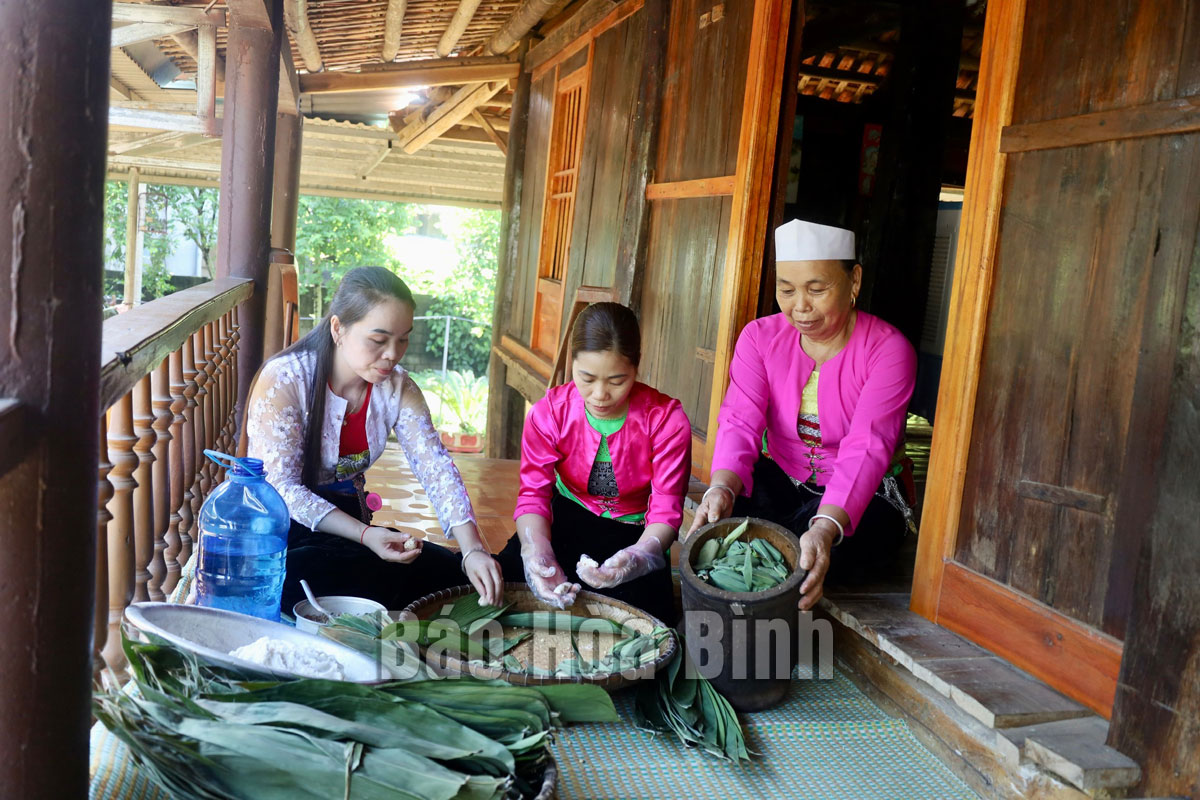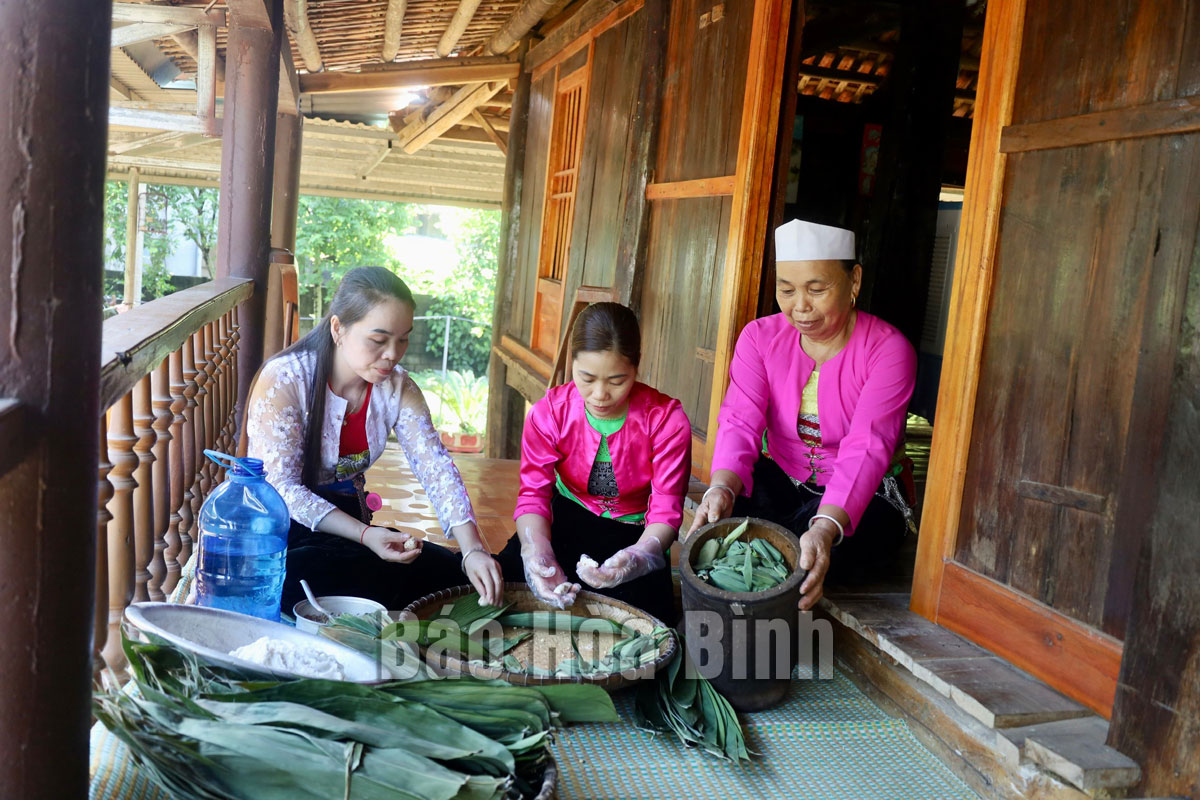
(HBO) - Muong Vang in Lac Son district is one of the four biggest and best-known Muong ethnic areas in Hoa Binh. With 91% of the local population being Muong ethnic people, the district has always paid special attention to preserving and developing the traditional cultural value.
Residents in Muong Vo region, Nhan Nghia commune (Lac Son
district), still keep the traditional cultural characteristics in their
traditional costumes and cuisine.
According to the elders in Muong Vang
, the name "Lac Son”
dates back to 1887, belonging to Lac Tho area (1466), and Lac Yen province
(1836). From 1886, Lac Son was a district of Hoa Binh province. From 1975 to
1991, it was part of Ha Son Binh province. It returned to Hoa Binh province
following the re-establishment of the province in 1991. The locality still
retains its rich traditional culture.
The acculturation and interference in the economy and culture and the Fourth
Industrial Revolution have affected the cultural values of the Muong ethnic
group in Lac Son district.
Some types of traditional cultural and artistic heritage are in danger of being
lost. Many young people do not know the Muong language or culture as well as
the habits of their ancestors.
After numerousups and downsinhistory, relics and scenic spots
in the locality have been restored and embellished to meet the cultural and
spiritual demand of the people, contributing to the locality’s socio-economic
development.
Special attention has been paid to collecting, inventorying, preserving and
displaying artifacts. The traditional house in the Muong Khoi War Zone and
relics in the district still keep many valuable artifacts in science, history,
and culture.
Diversity of tangible cultural heritage
The Stone Shelter of Vanh villageis one of the typical tangible cultural
heritage and the national archaeological relics discovered and studied in the
province. It is located at the foot of a white stone mountain in Khu Vanh
hamlet, next to the junior high school, not far from the center of the People's
Committee of Yen Phu Commune, among the four quiet mountains and forests.
The Stone Shelter of Vanh village was mentioned many times in the epic "De
dat, de nuoc” (the birth of land and water) of the Muong ethnic people in Hoa
Binh, the quintessential soul of a part of Muong Vang culture.
According to locals and history, the Stone Shelter of Vanh village is from Buoi
river, one associated with many generations of the people in Lac Son district,
locally known as the Ben Ky river section.
The Stone Shelter of Vanh village was discovered and excavated by French
archaeologist M. Colani in 1929 during an archaeological investigation in the
southern limestone area of Hoa Binh province. Locals also call the Stone
Shelter of Vanh village as a snail cave, because there are a lot of conches in
the cave.
The Stone Shelter of Vanh village is fairly large, measuring 30m in its
entrance, 18m in its depth, and 10m in its height, gradually lower inwards. The
stone roof is about 5m higher than the surrounding field. The entire part has
the traces of the cultural layers with the natural light, and the door faces
the southwest. In the picture taken by M. Colani in 1929, there is an old
banyan tree right next to the entrance of the stone roof, probably in the
period when the primitive people lived here, there were many large trees to
cover, possibly it was a thick forest in the past.
Carious types of the stone relics are found in the Stone Shelter of Vanh
village, besides the hewn tools such as triangular axes, short axes, the bladed
axes, axes with blade sharpening shoulders, full body axes, pestles, crushing
stones, stone rings, bone relics, horns, mollusk shells, and pottery relics.
The results of the excavation and the determination by C14 radiocarbon in the
Stone Shelter site of Vanh village published by M. Colani in 1930 showed that
it belongs to the Hoa Binh civilisation with a tensile date frame of 8,000 to
17,000 years ago.
The district is also home to other typical cultural - historical relic sites
such as Coi communal house in Vu Binh commune, Khoi communal house in An Nghia
commune, Khenh communcal house in Van Son commune, the historical memorial site
for the Tay Tien (March West) Regiment in Thuong Coc commune, Khu Dung cave in
Nhan Nghia commune, Bang communal house in Ngoc Lau commune, and the
"Truong Son anti-Japaneseguerrilla school” inBu Lot
hamlet,Tan My commune, among others.
Unique intangible cultural values
Coming Muong Vang in the spring, visitors will a have chance to enjoy the
bustling atmosphere of festivals, and experience the traditional cultural and
belief activities of locals.
Most festivals are held in January, such as the festivals of Khoi communal
house in An Nghia commune, Coi communal house in Vu Binh commune, Khenh
communal house in Van Son commune, and Thuong communal houses in Vu Ban town,
the Du Voi festival, the Truong Kha temple festival, and theXuong
Dong festivalin Yen Phu commune.
The organisation of traditional festivals have contributed to attracting more
tourists to the locality.
Local authorities have also paid heed to preserving other intangible cultural
heritage such as costumes, cuisine, language, ancestral worshiping rituals, Mo
Muong, folk songs and games, among others.
Notably, Muong Vang is seen as the cradle of folk songs and dances. There are
about 300 folk singers in the area.
According to Nguyen The Hung, head of the Culture and Information Office of Lac
Son district, local authorities have concentrated resources and taken many
solutions to preserve and promote the intangible cultural heritages of the
locality.
The district People's Committee has opened classes teaching gong performance,
Muong language, and making products from bamboo and rattan; set up folk song
singing clubs; preserved over 12,000 Muong stilt houses and more than 3,000
Muong gongs; and restoredand conserved10 traditional festivals./.
The People’s Committee of Lac Son district held a ceremony on April 28 to receive the provincial relic certificate for the ancient rock carving site at Suoi Co stream, located in My Thanh commune.
A special music show titled "The country is in the fullness of joy” has been held at Hoa Binh Square in Hoa Binh city in celebration of the 50th anniversary of the liberation of the South and national reunification (April 30, 1975–2025).
The People's Committee of Lo Son commune, Tan Lac district, has organised the local annual traditional stream fishing festival on April 19 - 20.
As a land deeply intertwined with human history and Vietnam’s millennia-long journey of nation-building and defence, Hoa Binh is often revered for its epic tales and legends.
Residents of Hoa Binh boast a rich cultural identity, reflected in their unique language, traditional attire, customs, and folk melodies – described as "sweet as honey, clear as a mountain stream.”
Lac Son district’s Vu ban town held the 2025 Truong Kha temple festival on April 12–13 (the 15th–16th days of the third lunar month). Since its revival in 2019, the festival has been organised every three years, preserving valuable intangible heritage while meeting the community’s cultural and spiritual needs.



